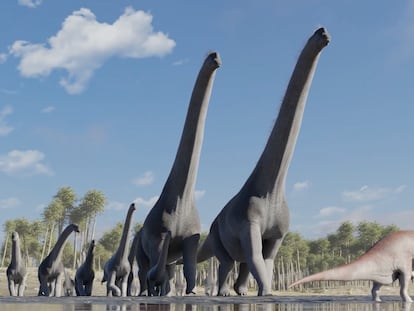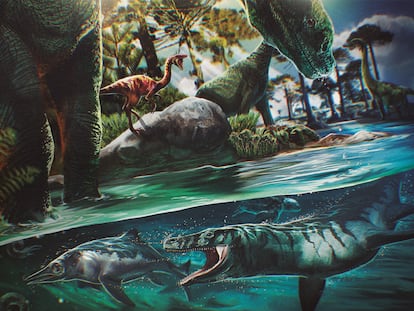Fossil of a teenage Tyrannosaurid discovered complete with last meal
The Gorgosaurus find in Canada reveals what these large predators fed on

Finding dinosaur bones is a cause for celebration in paleontology, but when a fossil is so well preserved as to include the remains of its last meal, it is even more amazing. This milestone occurred at Dinosaur Provincial Park in Alberta, Canada, in 2019, when a group of researchers from the Calgary University stumbled upon a Gorgosaurus libratus from approximately 75 million years ago that was between five and seven years old when it died with the hind legs of two small dinosaurs in its stomach.
After years of research to determine the age and species of these small dinosaurs, the scientists published their results this Friday, December 8, in the journal Science, confirming the theory that young Tyrannosaurids — the family of dinosaurs that includes Jurassic Park’s terrifying Tyrannosaurus rex — hunted young prey, focusing on animals they could take down on their own.
Part of a paleontologist’s work is to imagine the color, texture and entrails of beings that have ceased to exist. Lead author of the research, Canadian paleontologist François Therrien, and his colleagues were presented with a unique opportunity. The team discovered the Gorgosaurus fossil within a rock layer of what looks like an ancient river channel. Therrein explains that dinosaur bones are likely to be found in these types of environments, as rivers carry a lot of sedimentation and quickly bury the remains, helping to preserve them before scavengers get to them. However, it is unusual for them to be so extraordinarily preserved. It is also unusual for them to be juveniles as young specimens would have had more fragile bones. “This specimen represents the first example of gut remains in situ and provides direct fossil evidence of diet and feeding behavior in a young Tyrannosaurid,” says Therrien of the Tyrrell Paleontologist Museum.
As they separated the remains from the rock and exposed the bones, they noticed small toes poking through the Gorgosaurus’ rib cage. These were, in fact, the legs of two small dinosaurs. “It was exciting because it was the first time we had seen remains inside,” explains Therrien. However, the challenge then was to identify which small dinosaurs the limbs belonged to. After some time, they were able to establish that it was a Citipes, a species that lived more than 75 million years ago in what is now southwestern Canada. They also discovered that the young Gorgosaurus died shortly after eating its last prey.
Tyrannosaurids are a family of carnivores that dominated what is now Asia and North America until 66 million years ago, towards the end of the Cretaceous period. They are considered the largest land predators that ever existed, with the largest found measuring almost 13 meters long and weighing nearly 10 tons. The youngest were slender, with narrow skulls, razor-like teeth and long, slender hind limbs. Adults, on the other hand, were robust, with huge skulls and large banana-sized teeth capable of crushing their prey.
But these dinosaurs were not always colossal. They went from being hunters of small species during the Early Cretaceous period to predators of large herbivores, including Ceratopsians, Hadrosaurs and Sauropods, as they grew in size.
Until now, it has not been clear whether juveniles hunted smaller prey on their own or whether they benefited from the spoils of the pack, hunting with their elders. The finding of this Gorgosaurus sheds more light on the matter. According to Therrien, these and other Tyrannosaurids, including the infamous Tyrannosaurus rex, may have acted as intermediate predators in their youth, becoming top predators in adulthood.
The larger ones devoured every part of their prey, while juveniles preferred the high hips and left the rest. This suggests that immature and mature individuals occupied different ecosystems, which would have allowed juvenile and adult Tyrannosaurids to coexist “with limited conflict,” Therrien says, adding that, based on a single specimen, not much can be said about their social behavior. However, he suggests that Tyrannosaurids probably hunted in groups to ensure that everyone got enough food.
Experts highlight the similarities between the way these predators hunted and the hunting modus operandi of large modern reptiles, such as crocodiles and the world’s largest lizard, the Komodo dragon. Like Tyrannosaurids, these animals experience a shift in their eating habits as they grow, starting with smaller prey and progressing to larger animals. In terms of behavior, juveniles of both species are more likely to hunt in groups, and there is a transition in their diet as they mature.
Paleontologist José Luis Sanz, professor emeritus at Madrid’s Autonomous University, applauds the discovery and stresses that it sheds valuable light on an enigma surrounding this family of dinosaurs. He is not, however, surprised by the revelations. “It is the feeding behavior expected of Tyrannosaurids,” he says.
Although Therrien and his colleagues are aware that finding a fossil with the same characteristics again is very unlikely in the short term, their work will encourage the scientific community to review other dinosaurs found previously. The goal is to obtain more data and to investigate the behavior, ecology and feeding habits of Tyrannosaurids.
Sign up for our weekly newsletter to get more English-language news coverage from EL PAÍS USA Edition
Tu suscripción se está usando en otro dispositivo
¿Quieres añadir otro usuario a tu suscripción?
Si continúas leyendo en este dispositivo, no se podrá leer en el otro.
FlechaTu suscripción se está usando en otro dispositivo y solo puedes acceder a EL PAÍS desde un dispositivo a la vez.
Si quieres compartir tu cuenta, cambia tu suscripción a la modalidad Premium, así podrás añadir otro usuario. Cada uno accederá con su propia cuenta de email, lo que os permitirá personalizar vuestra experiencia en EL PAÍS.
¿Tienes una suscripción de empresa? Accede aquí para contratar más cuentas.
En el caso de no saber quién está usando tu cuenta, te recomendamos cambiar tu contraseña aquí.
Si decides continuar compartiendo tu cuenta, este mensaje se mostrará en tu dispositivo y en el de la otra persona que está usando tu cuenta de forma indefinida, afectando a tu experiencia de lectura. Puedes consultar aquí los términos y condiciones de la suscripción digital.
More information
Archived In
Últimas noticias
There is as much life left to discover on planet Earth as that which is already known
Dozens presumed dead, around 100 injured in fire at Swiss Alps bar during New Year’s celebration
Is porn for women different from conventional porn? We spoke to those who make it
Cartagena de Indias is sinking: What can the city do to mitigate it?
Most viewed
- Reinhard Genzel, Nobel laureate in physics: ‘One-minute videos will never give you the truth’
- David King, chemist: ‘There are scientists studying how to cool the planet; nobody should stop these experiments from happening’
- Sinaloa Cartel war is taking its toll on Los Chapitos
- Oona Chaplin: ‘I told James Cameron that I was living in a treehouse and starting a permaculture project with a friend’
- The Interoceanic Train, the Mexican alternative to the Panama Canal











































